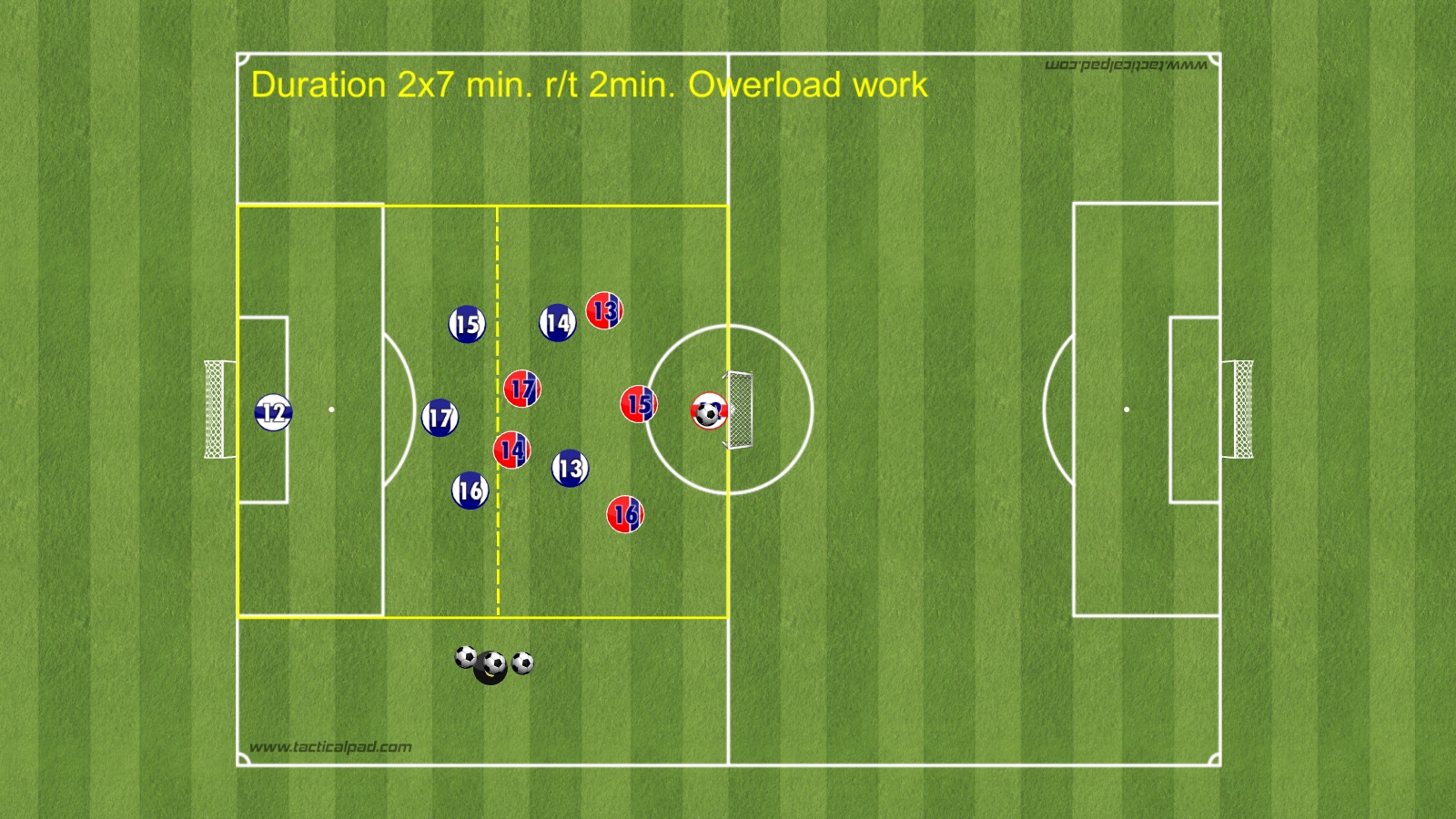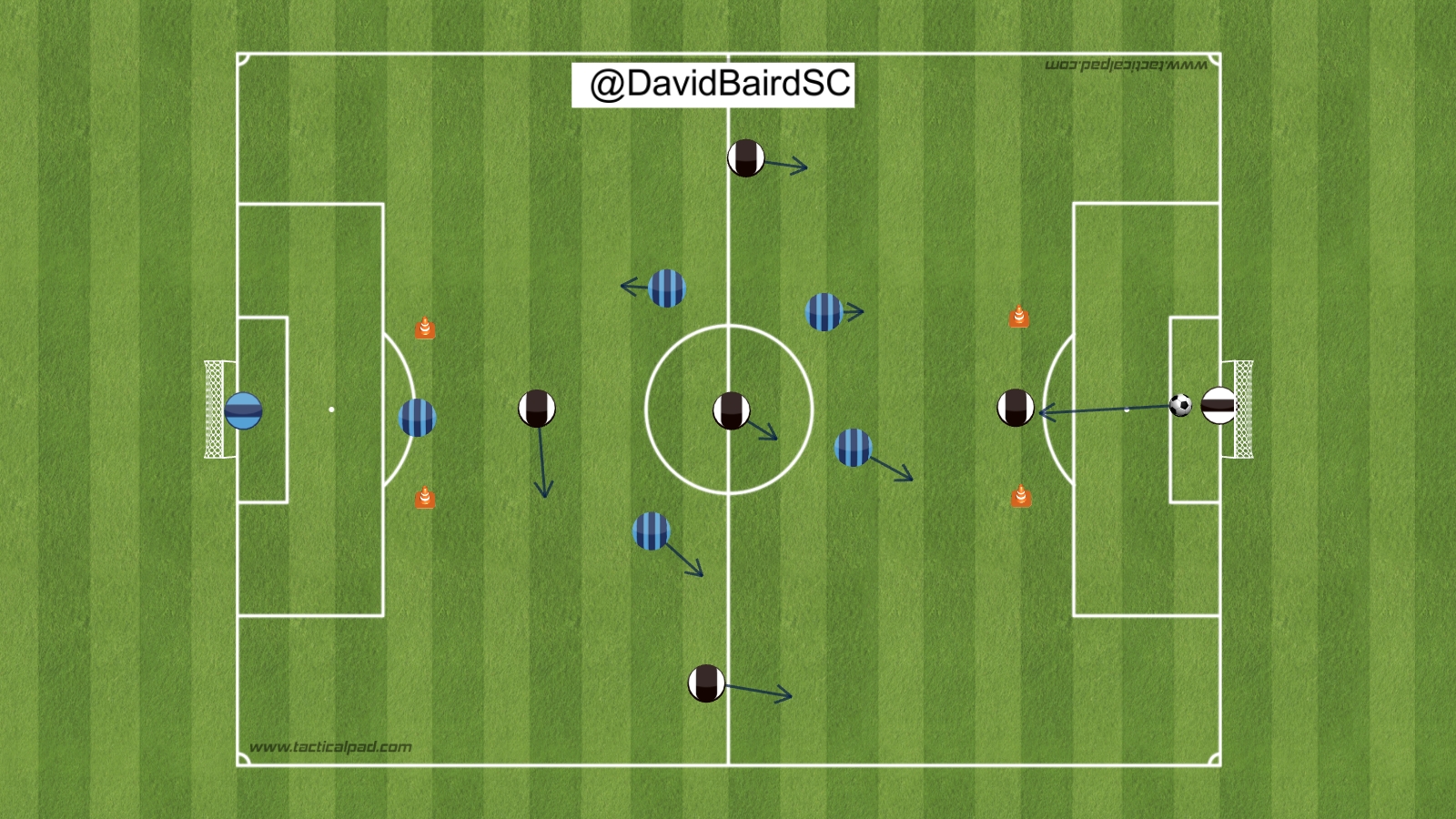GIOCO TRA LE LINEE
ESERCIZIO PER ALLENARE GIOCATORE IN APPOGGIO TRA LE LINEE + COMBINAZIONE APPOGGIO-SOSTEGNO PER IL CROSS + TRANSIZIONE DOPO RICONQUISTA.
In questa esercitazione abbiamo 4 gruppi composti da 3 giocatori, ma possono anche essere gruppi da 4 con qualche piccola variazione (ad es. una sola porta e due sponde esterne anche sul lato vicino al centrocampo e 4 elementi invece di 3 ad eseguire la combinazione esterna).
Esternamente al Settore evidenziato abbiamo una terna di giocatori che allenano il portiere sulle uscite , eseguendo a turno un cross in area di rigore dopo una combinazione appoggio-sostegno, che si sviluppa dopo una conduzione veloce di palla tra i coni da parte del giocatore che esegue il primo passaggio.
Al limite dell’area di rigore abbiamo tre sagome ognuna con una casacca di colore diverso (ROSSO, GIALLO, VERDE) ad indicare una linea difensiva
Nel Settore evidenziato si esegue un possesso palla 3vs3 + 3 jolly esterni. Le due squadre attaccano in modo direzionato ed hanno obiettivi diversi.
La squadra che attacca verso l’area di rigore (cioè verso la singola porta del Settore) ha a disposizione 2 appoggi (a fianco porta) ed un sostegno (tra le due porticine).
Obiettivo della squadra che attacca verso la porta grande (i gialli nel video), che è difesa da un portiere, è quello di servire uno dei due appoggi esterni (giocatori neri) dopo un determinato numero di passaggi.
Nel momento in cui si concretizza la giocata sull’appoggio il Mister chiamerà a gran voce “UOMO” oppure “SOLO”.
Se chiama “UOMO” il giocatore nero allora scarica sempre per un giallo il quale dovrà concludere a rete nella porta del Settore evidenziato per segnare il gol (prima parte del video).
Se chiama “SOLO” allora il giocatore nero si girerà verso le tre sagome colorate iniziando la conduzione della palla verso le 3 sagome. Il Mister chiamerà a questo punto un colore (nel video chiama il ROSSO) e l’altro giocatore nero senza palla attaccherà la sagoma indicata alle spalle andando a ricevere il filtrante del compagno per concludere a rete (terza parte del video).
La squadra che attacca verso le 2 porticine invece ha a disposizione un solo appoggio (tra le porticine) e due sostegni (a fianco porta grande).
Obiettivo di quest’ultima (i blu nel video) è quello di recuperare palla attraverso una pressione collettiva ad alta intensità, ed eseguire una transizione verso una delle due porticine per segnare il gol.
Se il gol (come nella seconda parte del video) avviene dopo appoggio sulla sponda nera tra le due porte il gol vale doppio.
Se avviene sempre tramite sponda, ma dopo massimo tre passaggi il gol vale triplo.
E’ da notare che le sponde nere a fianco della porta simulano due elementi (appoggi) che giocano tra due linee di pressione (quella dei 3 giocatori blu e quella costituita dalle 3 sagome colorate) e quindi sono gli elementi fondamentali dell’esercitazione.
Ruotare gli elementi nei vari ruoli ed eseguire i cross sia dalla parte destra che dalla parte sinistra.
December 23, 2024
COMBINAZIONI E POSSESSO PALLA
In questa esercitazione abbiamo due gruppi di giocatori disposti come nel video che inizialmente eseguono delle combinazioni in forma veloce .
Al segnale del Mister i giocatori si disporranno con due sponde per squadra sui vertici opposti, e si darà inizio ad un possesso palla con la regola che ogni volta che la sponda riceve la palla entra in campo e viene sostituita dal compagno da cui ha ricevuto il passaggio. Ad ogni cambio sponda si assegna un punto. Se il cambio sponda avviene dapprima su un vertice e poi il successivo sul vertice opposto si assegnano tre punti.
December 23, 2024
FOLLOW THE LEADER
Follow the Leader:
6 players and 2 footballs.
The blue ball is the 'leader' and as that is passed the player in possession of the red ball must pass to keep both balls always opposite each other.
The cones show the opposite place for each pass but this is purely for the purpose of the animation.
This is a slow passes passing warm up to get all players scanning, thinking and communicating. Players can take a couple of touches to make the drill work and when they don't have a ball at their feet it's an oppertunity to stretch off and get ready for the session ahead. (This is a pre-training exercsie great for players to do when arriving early)
Possible Progression: 1 touch would raise the tempo of both balls
Advanced Progression: Simply turn it into a rondo with a defender in the middle trying to intercept (no tackling - that can be an even more advanced progression if you wish) the blue ball. Again it's justa rondo with the blue ball the key ball but the players are also challenged by trying to keep the red ball opposite the blue all the time - to aid succes start with a faily large area for your rondo.
December 23, 2024
ACTIVATION
2v1 with recovering defender. Painting the picture and stressing the importance of decision making for young players.
With a brief numbers advantage the aim here is to play quick and create a chance on goal. If the defender presses the player on the ball the best option may be to pass to the other player, if they stand off then going alone and taking a shot may be the best option.
Defending - coach delaying the attack by cutting off the pass with a side on body position and trying to narrow down the angle for the player on the ball, always showing away from goal and delaying for the recovering defender to get back.
If the defenders win the ball they have a goal they can score into.
Teach striker movement, scanning to know what's around you and show young players there options depending on what the defenders decide to do. Make it fun and competitive between the teams
December 23, 2024
OVERLOAD WORK
Set up: Pitch 50x45m
Organization: Players play 5vs5+GK game on 50x45m. field at the high tempo game. Goal applies when all players in organization of attack cross the center line. Game play players who have not played the game and players who have play to 60.min
December 23, 2024
DOPPIO 4 CONTRO 4 CON CONCLUSIONE A RETE
In questa esercitazione abbiamo inizialmente due partite eseguite in situazione di 4vs4 in due Settori. Si gioca regolarmente per segnare il gol nelle porticine indicate in ognuno dei Settori. Al segnale del Mister saranno chiamati un giocatore per squadra per ogni Settore. I giocatori chiamati dal Mister devono uscire dal proprio Settore ed ognuno deve posizionarsi sul cono iniziale : si avranno pertanto, temporaneamente, due situazioni di 4vs3 in entrambi i Settori (ciascuna squadra avrà superiorità numerica). Al secondo segnale del Mister i giocatori usciti dal proprio Settore devono eseguire ognuno il percorso indicato in figura tra i coni (vai – torna - vai lineare e successivi cambi di direzione) fino a raggiungere il pallone posizionato nel Settore ad inizio area di rigore . I giocatori si sfideranno in un 1vs1 con palla in possesso di chi arriva per primo nel Settore dopo il percorso. Alla fine del duello (con gol da realizzare entro 5 secondi pena l’interruzione dell’1vs1) entrambi i giocatori rientrano nel proprio Settore iniziale a ristabilire la parità numerica.
Successivamente il Mister chiama un'altra coppia di giocatori ad eseguire lo stesso percorso, e così via per il tempo stabilito dal Mister.
December 23, 2024
Learning in the Game
There is always a first time for everything, to question yourself, to learn, to grow, to move away from a safe haven, to overcome limits through knowledge, to do all these things together in the time of a choice. However, every time you really ask yourself about learning in the game of football, everything changes, it is a first time different from all the others, because learning in the game of football is a universe in which you can travel endlessly, without ever feeling like you have reached a goal. A journey into emotions and complexity. To approach the game in its essence, to touch its atom, you have to get lost and go there where no compass can be able to "correct" the steps following a score. We have always been taught to be tightrope walkers who, on a tightrope, never look down, do not accept the fear of failure, ready to set the goal ahead as the only imperative. without asking questions. Fiercely, we identified the objective with victory, with quantity, often forgetting the importance of the path and the quality in the obvious "it has always been done this way". A rigid linearity that hides within itself that undergrowth of illusions which have slowly transformed the certainties of a few into an untouchable culture for many. Yet it doesn't add up, there is something that the game of football in all its manifestations promptly tries to tell us, when like smoke it flows through the fingers and refuses to be controlled, grasped and understood. And so, it happens that something doesn't go right and that, in the cracks of a fleeting thought, the possibility of discovery, of evolution, of comparison, of a horizon that transforms the tightrope walker into a diver creeps in. A dive into uncertainty, far from protagonism, a dive preceded by a long walk on a tangled wire, with the head going up and down incessantly. Because if learning is born and grows through trial and error then it will always be considered as a seesaw that oscillates between what you feel on your skin and what vibrates in your stomach. Emotions and perceptions. My reflections do not start from the analysis of how much, over time, we have chosen to de-structure the game and in fact its complexity, but I would like to emphasize the question. Every time I observe one of my teams emerging freely from the chaos , whether in a simple development of progression, rather than in a duel or perhaps in an offensive transition in the open field in numerical superiority, is a wonderful first time that makes me reflect. In that mix of emotions and previous experiences that make learning an unconscious awareness with every gesture, choice, interpretation of the changing circumstance, which always creates a crossroads, I get lost. We create contexts in which the complex footballer system and the complex team system know how to move in entropy, in that disorder that leads to the emergent behaviors that will be the basis for the construction of the Game Model (through the Principles ). The created context (space - opposition - objectives) in turn determines the environment in which the systems attract each other, modifying the starting points and generating that self-organization which will be the distinctive feature of their be in the game. The resulting environment will in turn self-organize, stimulated by the systems involved (single-collective-observers), a self-echo self-organization that increases entropy and increasingly distances the possibility that some type of compass, even the most sophisticated one can predict the outcome of a development (with or without the ball, let alone during transitions).
3v3+3c MULTIPLE WORMHOLE




